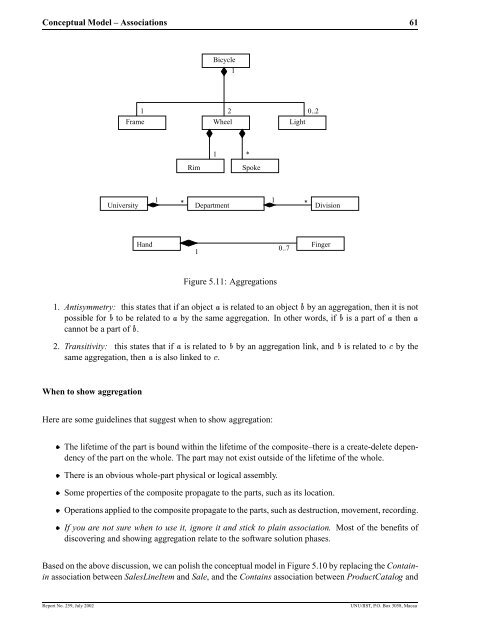- Page 1 and 2:
UNU/IISTInternational Institute for
- Page 3 and 4:
UNU/IISTInternational Institute for
- Page 5 and 6:
ContentsiContents1 Introduction 11.
- Page 7:
Contentsiii8.3 Questions . . . . .
- Page 11 and 12:
Chapter 1IntroductionTopics for Cha
- Page 13 and 14:
Introduction to Software Engineerin
- Page 15 and 16:
Chapter 2Software Development Proce
- Page 17 and 18:
Software Development Process 7Devel
- Page 19 and 20: Software Development Process 9There
- Page 21 and 22: Evolutionary Development 11Requirem
- Page 23 and 24: ¦§¤Questions 13Source of errorEf
- Page 25 and 26: Chapter 3Introduction to OO Develop
- Page 27 and 28: Mastering Complex Systems 17The pro
- Page 29 and 30: Mastering Complex Systems 19roots a
- Page 31 and 32: Mastering Complex Systems 215. A co
- Page 33 and 34: The Rest of The course 23Main funct
- Page 35 and 36: Questions 253. Fred is a Dodge deal
- Page 37 and 38: Chapter 4Requirement Capture and An
- Page 39 and 40: Understanding requirements 29Use ca
- Page 41 and 42: Understanding requirements 31Ref #
- Page 43 and 44: Use Cases: Describing Processes 334
- Page 45 and 46: Use Cases: Describing Processes 354
- Page 47 and 48: Use Cases: Describing Processes 371
- Page 49 and 50: Use Cases: Describing Processes 394
- Page 51 and 52: Use Cases: Describing Processes 41B
- Page 53 and 54: Use Cases: Describing Processes 43C
- Page 55 and 56: Questions 45How can you, as a requi
- Page 57 and 58: Chapter 5Requirement Capture and An
- Page 59 and 60: Conceptual Model - Concepts and Cla
- Page 61 and 62: Conceptual Model - Concepts and Cla
- Page 63 and 64: Conceptual Model - Concepts and Cla
- Page 65 and 66: Conceptual Model - Associations 55*
- Page 67 and 68: Conceptual Model - Associations 57b
- Page 69: Conceptual Model - Associations 59A
- Page 73 and 74: Conceptual Model-Attributes 63uses:
- Page 75 and 76: Conceptual Model-Attributes 65Keep
- Page 77 and 78: Conceptual Model-Attributes 67Desig
- Page 79 and 80: Steps to Create a Conceptual Model
- Page 81 and 82: Recording Terms in the Glossary 71R
- Page 83 and 84: Questions 73Term Category CommentsB
- Page 85 and 86: Questions 7513. Consider the follow
- Page 87 and 88: Chapter 6System Behaviour: System S
- Page 89 and 90: System Sequence Diagram 79Make Phon
- Page 91 and 92: System Sequence Diagram 81Buy Items
- Page 93 and 94: Contracts for System Operations 83d
- Page 95 and 96: Contracts for System Operations 856
- Page 97 and 98: Contracts for System Operations 87R
- Page 99 and 100: Chapter 7Design Phase: Collaboratio
- Page 101 and 102: Collaboration Diagrams 91this reque
- Page 103 and 104: Collaboration Diagrams 93msg1():POS
- Page 105 and 106: Collaboration Diagrams 95msg1()1a:[
- Page 107 and 108: Creating Collaboration Diagrams 977
- Page 109 and 110: Creating Collaboration Diagrams 99T
- Page 111 and 112: Creating Collaboration Diagrams 101
- Page 113 and 114: Creating Collaboration Diagrams 103
- Page 115 and 116: Creating Collaboration Diagrams 105
- Page 117 and 118: Creating Collaboration Diagrams 107
- Page 119 and 120: Creating Collaboration Diagrams 109
- Page 121 and 122:
Creating a new ¿-ÀÁ†ÆDÂ;Ã]
- Page 123 and 124:
Creating Collaboration Diagrams 113
- Page 125 and 126:
Creating Collaboration Diagrams 115
- Page 127 and 128:
Creating Collaboration Diagrams 117
- Page 129 and 130:
Creating Collaboration Diagrams 119
- Page 131 and 132:
Creating Collaboration Diagrams 121
- Page 133 and 134:
Creating Collaboration Diagrams 123
- Page 135 and 136:
Questions 125(a) an object Ù recei
- Page 137 and 138:
Chapter 8Implementing a DesignTopic
- Page 139 and 140:
Mapping a Design to Code 1298.2.1 D
- Page 141 and 142:
Mapping a Design to Code 1318.2.3 D
- Page 143 and 144:
Mapping a Design to Code 133public
- Page 145 and 146:
Chapter 9Advanced Modelling Concept
- Page 147 and 148:
Iterative Development Process 137De
- Page 149 and 150:
Iterative Development Process 139Al
- Page 151 and 152:
Generalisation 1410..1CashPaymentSa
- Page 153 and 154:
Generalisation 143of the supertype
- Page 155 and 156:
Figure 9.9: Justifying the subtypes
- Page 157 and 158:
More about Associations 147Payment*
- Page 159 and 160:
More about Associations 149Storeadd
- Page 161 and 162:
Packages: Organizing Elements 151A
- Page 163 and 164:
Modelling Behaviour in State Diagra
- Page 165 and 166:
Modelling Behaviour in State Diagra
- Page 167 and 168:
Modelling Behaviour in State Diagra
- Page 169 and 170:
Modelling Behaviour in State Diagra
- Page 171 and 172:
Modelling Behaviour in State Diagra
- Page 173 and 174:
Chapter 10Summing UpTopics of Chapt
- Page 175 and 176:
Summing Up 165Conceptual ModelsCate
- Page 177 and 178:
¢¢¢¢¢Chapter 11Coursework11.1
- Page 179:
Bvis Car Hire Company: The Problem
















